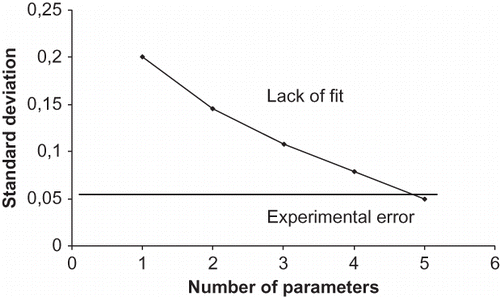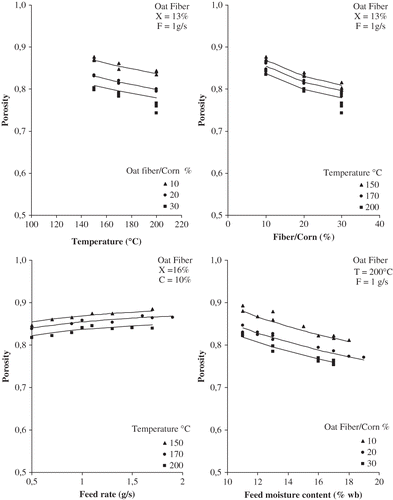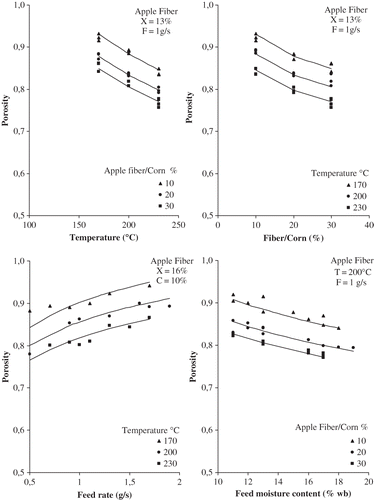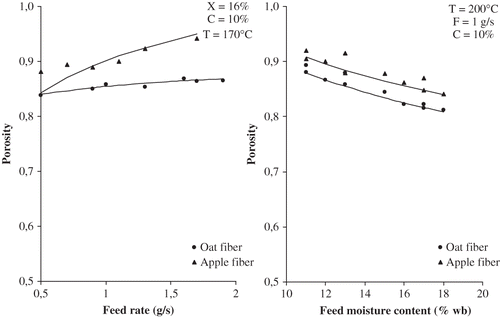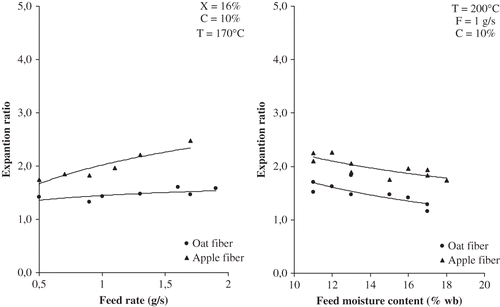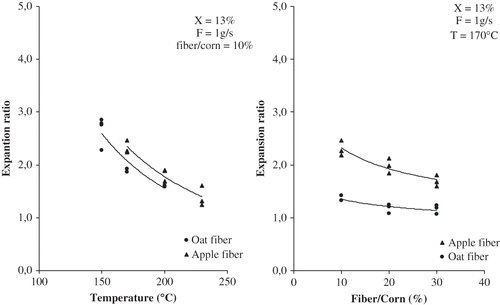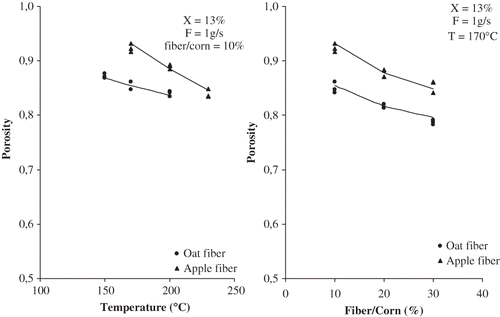Abstract
Structural properties, such as apparent density, true density, expansion ratio, and porosity, of extruded corn grits enriched with plant fibers were measured. The effect of extrusion conditions, including feed rate (0.7–1.9 g/s), feed moisture content (13–19% wet basis), and extrusion temperature (150–230°C) on structural properties of corn-based extrudates enriched with apple and oat fibers was studied. The ratio of the two fibers to corn flour was ranging from 10 to 30% (fiber/corn). A simple power model was used to correlate porosity with extrusion conditions and material characteristics. Porosity of extrudates was found to decrease with temperature, feed moisture content and fiber to corn ratio, and to increase with feed rate for both the examined fibers. Generally, the addition of fibers led to more dense products. Comparatively, the usage of apple fiber in mixtures for the production of snacks led to a product with higher porosity than those with oat fiber.
INTRODUCTION
Dietary fiber is the indigestible component of foods that includes cellulose, hemicellulose, lignins, pectins, gums, and mucilages.Citation[1, Citation2] Its beneficial effects on human health have received much attention. Increased fiber consumption has been found to be important for lowering the risk of being overweight and associated with reduced body mass index, blood pressure and glucose concentration.Citation[3, Citation4] Lack of adequate dietary fiber in the diet is associated with constipation, diverticulosis, cardiovascular disease, and cancer.Citation[5, Citation6] For instance, when the British Health Education Council (1983) recommended multiple changes in the national diet, a 50% increase in dietary fiber was proposed, the largest single-component change in the present diet.[5] Although dietary fiber-rich materials have gained popularity as food ingredients for health benefits, relatively little is yet known about the effects of thermal food processing (drum drying, jet cooking, or extrusion cooking) on functional and physical properties of fiber foods.Citation[7, Citation8]
Extrusion cooking is a heat process in which the material is subjected to intense mechanical shear; moistened starchy or proteinaceous foods are worked into a viscous, plastic-like dough and cooked before being forced through the die. The intense structural disruption and mixing facilitates reactions otherwise limited by diffusion of reactants and products.Citation[9] Some advantages and disadvantages of cooking during the extrusion process are the gelatinization of starch, denaturation of proteins, inactivation of native enzymes, which causes food deterioration during storage, inactivation of antinutrient factors,Citation[10 Citation–12] and reduction of microbial counts in the final product.Citation[13] The physical properties and sensory attributes of an extruded product are influenced by extrusion variables such as extruder type, screw configuration, feed moisture, temperature profile in the barrel sections, screw speed, and feed rate. Intensive research projects have been focused on these variables to optimize extrusion process and product quality properties.Citation[14 Citation–22]
Texture is one of the most important factors in the quality properties of extruded snack products. The degree of expansion determines the extrudate structure and consequently its texture.Citation[15, Citation23, Citation24] Extrudate expansion has been reported to depend mostly on material moisture content and extrusion temperature.Citation[25– Citation27] During extrusion cooking of biopolymers, the viscoelastic material is forced through a die so that a sudden pressure drop causes part of the water to vaporize, giving an expanded porous structure.Citation[26, Citation28] Extrudate structure is stabilized as the matrix transform to a glassy state on cooling and drying.Citation[29]
In addition, the presence and content of dietary fiber, also plays an important role on structural properties of fiber extruded products. Incorporating high levels of fiber in extruded products has often resulted in a compact, tough, non-crisp, and undesirable texture in extrudates, as a result of reduced expansion.Citation[30] The purity, as well as the protein and lipid level, of fibers influences expansion properties of extrudate products.Citation[31] Various fiber sources such as soy hull, oat bran, fruits and rice bran are used to boost the fiber content mostly in baked products.Citation[3] The addition of those fiber sources to extrudate products will affect their texture. The objective of this study is to investigate the effect of process conditions (temperature, feed rate) and material characteristics (moisture content, corn to fiber ratio) on porosity and expansion ratio of two corn-fiber mixtures (including oat and apple fibers). A simple empirical mathematical model was developed, to predict porosity as a function of process conditions and material characteristics.
MATHEMATICAL MODELING
A simple mathematical model has been proposed in the literature to predict structural properties of materials during drying as function of moisture content.Citation[32] Extruded products are assumed to have very low levels of moisture content after extrusion process, even if initial materials have various moisture contents, so their structural properties, namely, true density, apparent density, and porosity, are similar to the structural properties of dried materials at zero moisture content.Citation[33] True density of the samples was determined using the equation:
The porosity of the extrudates was determined from the true and apparent density, using the equation:
The values of the model parameters for the calculation of porosity as a function of extrusion conditions and initial raw materials characteristics are determined by fitting the proposed model to the experimental data. The method used is described by Lazou et al.Citation[33] Following regression analysis procedure, all five parameters can be determined simultaneously. However, all of these parameters do not affect the sum of squares of the residuals to the same degree. In order to distinguish between the ones that are necessary to accurately predict the porosity, the following procedure was adopted. Firstly the minimum change in sum of squares (SST) was estimated for all five parameters and mean deviation (SR ) was evaluated. Secondly, omitting one parameter at a time, the values of SR was evaluated for all combinations of the five remaining parameters. In this way, the parameter chosen to be eliminated was the one whose elimination produced the minimum SR . Continuing the former procedure, the minimum values of SR were evaluated for 4, 3, 2, and 1 parameters, respectively. In , a typical figure is shown depicting SR and SE as a function of the number of parameters. The group of parameters, which gives a lack of fit (SR ) close to mean experimental error (SE ), is the one that involves the required number of parameters for predicting porosity.
Table 1 Chemical composition of raw materials (g/100 g)
Table 2 Extrusion conditions and material characteristics
MATERIALS AND METHODS
Sample Preparation
Yellow corn flour was mixed with fiber flour (oat and apple fiber). Apple and oat fiber were purchased from J. Rettenmaier & Sohne GmbH, CokG Germany. Material characteristics are shown in . Distilled water was added to adjust moisture content. All the ingredients of each preparation were mixed in a mixer for 15 min, to increase homogenization. After mixing, the samples were packed under vacuum and stored. The chemical composition of materials used is shown in .
Extrusion Cooking
A prism Eurolab conical, counter-rotating twin screw extruder, model KX-16HC (Prism Eurolab, Staffordshire, UK), was used. The general screw geometry was as follows: length: 40 cm; diameter: 16 mm; maximum rotation speed: 8.33 Hz (500 rpm); and die diameter: 3 mm. The material was fed into the extruder with a volumetric feeder. The extruder had five temperature control zones. The pressure at the die during extrusion was measured with a pressure transducer. All extrusion conditions were displayed on the control panel (barrel and screw die temperature, screw speed). The temperature during extrusion was adjusted by varying the temperature in the barrel, screw, and die. The extrusion conditions are shown in . Steady state conditions were reached after 20 min, and then samples were collected, left on a table to dry for 6 h and stored in glass jars under vacuum and ambient temperature for further structural properties measurements.
RESULTS AND DISCUSSION
The application of regression analysis for each type of sample showed that the optimum number of parameters that affect porosity are four (extrusion temperature, feed rate, initial moisture content, and fiber to corn ratio), while the equation constants are five (). These parameters were ϵ0, nT , nF , nX , and nC . A comparison between predicted porosity and experimental data is shown in and Experimental measurements are summarized in , while in the corresponding parameter estimates for all materials are shown. The reference values of the parameters are Tr = 200°C, Fr = 1.15 gr/s, Xr = 15% wet basis, and Cr = 20% wet basis. These values were selected after the completion of initial experiments with the examined materials in order to achieve significant expansion of the final product and at the same time the required torque not to exceed the extruder specification. Also the combination of feed rate and extrusion temperature used aimed to avoid the burning of the product during extrusion.
In and , porosity of extrudates is represented as a function of feed rate, feed moisture content, extrusion temperature, and corn to fiber ratio. Solid lines are used for predicted values of porosity using the mathematical model and the parameters of . As can be seen, in all extrudates, porosity was decreased with temperature. Hasimoto and GrossmannCitation[35] and Miranda et al.Citation[36] observed a similar effect on porosity and expansion ratio at similar operation conditions. ParkCitation[37] proposed that puffing phenomena of extrudates result from the vaporization of superheated water as the extrudate exits the die. The simultaneous flash off of vapor expands the starch material, resulting in a porous, strong like structure within the extrudate. The degree of expansion is closely related to the size, number and distribution of air cells surrounding by the cooked material.Citation[30, Citation35] However, at high temperature (higher than 150°C), the vaporization occurs in a violent way and may cause breakage of the structure, hampering expansion and decreasing total porosity.Citation[38, Citation39]
Increased feed rate led to a slight increase of extrudate porosity at all type of corn-fiber blends. Increased feed rate would influence the degree of fill, inducing the degradation of amylopectin networks, and change the melt rheological characteristics thus leading to greater elastic effect and changes in product porosity.Citation[10, Citation23, Citation40– Citation42] Feed moisture content also influence total porosity of extrudates; as it was raised porosity decreased. This is an expected result and several studies in the past reported similar results.Citation[17, Citation23, Citation39, Citation42– Citation44] Moisture content during extrusion plays a critical role due to its multiple roles of plasticizer, gelatinization aid and blowing agent. Higher moisture in the barrel results in reduced viscosity and thus less mechanical energy into the melt and correspondingly lower temperatures. Higher water values enable material to undergo a glass transition temperature during the extrusion process. This facilitates the deformation of the matrix resulting in collapse phenomenon.Citation[45]
It was observed that increasing the amount of fiber, porosity decreased. It is generally known, that the addition of oat or apple fibers leads to products which are usually compact, tough, not crisp due to their fat and fiber content.Citation[30, Citation46] The comparison of the porosity of the extruded products for two types of fibers at the same experimental conditions is shown in It is clear that the extrudates containing oat fibers had lower values of porosity than the extrudates containing apple fibers. This might be due to their different lipid and fiber content (). Another crucial property of the extruded products is the expansion ratio. The values of expansion ratio for each type of extrudate are shown in It is obvious that expansion ratio of both the examined fibers has the same trend with porosity values.
Table 3 Experimental values
Table 3 (Continued)
Table 4 Results of parameter estimation
CONCLUSIONS
Porosity of expanded corn-fiber snacks, produced on a twin screw extruder, was dependent on several process conditions. Extrusion temperature and feed rate as well as material characteristics (feed moisture content, corn to fiber ratio) had some significant effect on extrudate porosity and expansion ratio. Porosity of extrudates was found to decrease with increasing temperature, feed moisture content and ratio of fibers and to increase with feed rate. The addition of fibers produces more dense products. Comparatively, the usage of apple fiber in mixtures for the production of snacks leads to product with greater porosity than the usage of oat fiber.
| NOMENCLATURE | ||
| C | = |
Fiber/corn ratio |
| d | = |
Diameter (cm) |
| F | = |
Feed rate (kg/s) |
| L | = |
Extrudates length (cm) |
| m | = |
Extrudates mass (g) |
| nC | = |
Corn/fiber ratio constant |
| ni | = |
Number of replicates |
| nT | = |
Temperature constant |
| nX | = |
Feed moisture content constant |
| nF | = |
Feed rate constant |
| SE | = |
Standard experimental error |
| SR | = |
Standard deviation between experimental and predicted values |
| SST | = |
Total sum of squares |
| T | = |
Extrusion temperature (°C) |
| Vt | = |
True volume (cm3) |
| X | = |
Feed moisture content (kg/100 kg wb) |
| Greek Symbols | = | |
| ϵ | = |
Porosity |
| ϵ o | = |
Porosity in reference conditions |
| ρ a | = |
Apparent density (g/cm3) |
| ρ t | = |
True density (g/cm3) |
| Subscripts | = | |
| r | = |
Reference |
REFERENCES
- Williams , S.R. 1985 . Nutrition and Diet Therapy , 5th , 21 – 48 . New York : Time/Mirror/Mosby College Publishing .
- Goñi , I. , Díaz-Rubio , M.E. , Pérez-Jiménez , J. and Saura-Calixto , F. 2009 . Towards an updated methodology for measurement of dietary fiber, including associated polyphenols, in food and beverages . Food Research International , 42 : 840 – 846 .
- Gajula , H. , Liu , S. , Alavi , S. , Herald , T. , Mald , R. , Bean , S.R. and Tilley , M. 2009 . Pre-cooked fiber enriched wheat flour obtained by extrusion: Rheological and functional properties . International Journal of Food Properties , 12 : 27 – 44 .
- Walsh , M.K. and Wood , A.M. 2010 . Properties of extrusion—Expanded whey protein products containing fiber . International Journal of Food Properties , 13 : 702 – 712 .
- Trowell , H. , Burkitt , D. and Heaton , K. 1985 . Dietary Fiber, Fiber-Depleted Foods and Disease , New York : Academic Press .
- McCleary , B.V. 2007 . An integrated procedure for the measurement of total dietary fibre (including resistant starch), non-digestible oligosaccharides and available carbohydrates . Analytical and Bioanalytical Chemistry , 389 : 291 – 308 .
- Gualberto , D.G. , Bergman , C.J. , Kazemzadeh , M. and Weber , C.W. 1997 . Effect of extrusion processing on the soluble and insoluble fiber, and phytic acid contents of cereal brands . Plant Foods for Human Nutrition , 51 : 187 – 198 .
- Lee , S. and Inglett , G.E. 2006 . Rheological and physical evaluation of jet-cooked oat bran in low calorie cookies . Journal of Food Science and Technology. , 41 : 553 – 559 .
- Asp , N.J. and Bjorck , I. 1989 . “ Nutritional properties of extruded foods. In: Extrusion Cooking ” . In American Association of Cereal Chemists Edited by: Mercier , C. , Linko , P. and Harper , J.M. 339 – 434 . St. Paul , MN
- Edwards , R.H. , Becker , R. , Mossman , A.P. , Gray , G.M. and Whiteland , L.C. 1994 . Twin extrusion cooking of small white beans (Phaseolus vulgaris) . Lebensm.-Wiss. Technology , 27 : 472 – 481 .
- Rackis , J.J. , McGhee , J.E. and Booth , A.N. 1975 . Biological threshold levels of soybean trypsin inhibitors by rat bioassay . Cereal Chemistry , 52 : 85 – 92 .
- Steel , C.J. , Sgarbieri , V.C. and Jackis , M.H. 1995 . Use of extrusion technology to overcome undesirable properties of hard-to-cook dry beans (Phasseolus vulgaris L.) . Journal of Agricultural and Food Chemistry , 43 : 2487 – 2492 .
- Harper , J.M. 1981 . Extrusion of Foods, Vols. 1 and 2 , Boca Raton , FL : CRC Press .
- Ahmed , Z.S. 1999 . Physico-chemical, structural and sensory quality of corn-based flax-snack . Nahrung , 43 : 253 – 258 .
- Ali , Y. , Hanna , M.A. and Chinnaswamy , R. 1996 . Expansion characteristics of extruded corn grits. Lebensm.-Wiss . Technology , 29 : 702 – 707 .
- Alonso , R. , Orue , E. , Zabalza , M.J. , Grant , G. and Marzo , F. 2000 . Effect of extrusion cooking on structure and functional properties of pea and kidney bean proteins . Journal of the Science of Food and Agricultural Chemisty , 80 : 397 – 403 .
- Fernadez-Gutuerrez , J.A. , Martin-Martinez , E.S. , Martinez-Bustos , F. and Cruz-Orea , A. 2004 . Physicochemical properties of casein-starch interaction obtained by extrusion process . Starch Journal , 56 : 190 – 198 .
- Iwe , M.O. 1998 . Effects of extrusion cooking functional properties of mixtures of full-fat soy and sweet potato . Plants Foods and Human Nutrition , 53 : 37 – 46 .
- Rocha-Guzman , N.E. , Gallegos-Infante , J.A. , Gorzalez-Laredo , R.F. , Castillo-Antonio , P.A. , Delgado-Licon , E. and Ibarra-Perez , F. 2004 . Functional properties of three common bean (Phaseolus vulgaris) cultivars stored under acceleraded conditions followed by extrusion. Lebensm.-Wiss . Technology , 39 : 6 – 10 .
- Sebio , L. and Chang , Y.K. 2000 . Effect of selected parameters in extrusion of yam flour (Dioscorea rotundata) on physicochemical properties of the extrudates . Nahrung , 44 : 96 – 101 .
- Seker , M. 2005 . Selected properties of native or modified maize starch/soy protein mixtures extruded at vary screw speed . Journal of the Science of Food and Agriculture. , 85 : 1161 – 1165 .
- Chang , Y.H. and Ng , P.K.W. 2011 . Effects of extrusion process variables on quality properties of wheat-ginseng extrudates . International Journal of Food Properties , 14 ( 4 ) : 914 – 925 .
- Ilo , S. , Tomschik , E. , Berghofer , E. and Mundigler , N. 1996 . The effect of extrusion operating conditions on the apparent viscosity and the properties of extrudates in twin-screw extrusion cooking of maize grits . Lebensmittel-Wissenschaft und Technologie , 29 : 593 – 598 .
- Kokini , J.L. , Chang , C.N. and Lai , L.S. 1992 . “ The role of rheological properties of extrudate expansion ” . In Food Extrusion Science and Technology , Edited by: Kokini , J.L. , Ho , C. and Karwe , M.V. 631 – 652 . New York : Marcel Dekker .
- Alvarez-Martinez , L. , Kondury , K.P. and Harper , J.M. 1989 . A general model for expansion of extruded products . Journal of Food Science , 53 : 609 – 615 .
- Kumagai , H. , Kumagai , H. and Yano , T. 1993 . Critical bubble radius for expansion in extrusion cooking . Journal of Food Engineering , 20 ( 4 ) : 325 – 338 .
- Hagenimana , A. , Ding , X. and Fang , T. 2006 . Evaluation of rice flour modified by extrusion cooking . Journal of Cereal Science , 43 : 38 – 46 .
- Padmanabhan , M. and Bhattachayray , M. 1989 . Extrudate expansion during extrusion cooking of foods . Cereal Food Word , 34 : 945 – 949 .
- Liu , S. , Alavi , S. and Abughoush , M. 2011 . Extruded moringa leaf–oat flour snacks: physical, nutritional, and sensory properties . Interernational Journal of Food Properties , 14 ( 4 ) : 854 – 869 .
- Lue , S. , Hsieh , F. and Huff , H.E. 1991 . Extrusion cooking of corn meal and sugar beet fiber: Effects on expansion properties, starch gelatinization and dietary fiber content . Cereal Chemistry , 68 : 227 – 234 .
- Huber , G.R. 1991 . Carbohydrates in extrusion processing . Food Technology , 45 ( 3 ) : 160 – 161 . 168
- Krokida , M.K. , Zogzas , N.P. and Maroulis , Z.B. 1997 . Modeling shrinkage and porosity during vacuum dehydration . International Journal of Food Science and Technology. , 32 : 445 – 458 .
- Lazou , A.E. , Michailidis , P.A. , Thymi , S. , Krokida , M.K. and Bisharat , G.I. 2007 . Structural properties of corn-legume based extrudates as a function of processing conditions and raw material characteristics . International Journal of Food Properties , 10 ( 4 ) : 721 – 738 .
- Launay , B. and Lisch , L.M. 1983 . Twin-screw extrusion cooking of starch pastes, expansion and mechanical properties of extrudates . Journal of Food Engineering , 2 : 259 – 280 .
- Hashimoto , J.M. and Grossmann , M.V.E. 2003 . Effects of extrusion conditions on quality of cassava bran/cassava starch extrudates . International Journal of Food Science and Technology , 38 : 511 – 517 .
- Miranda , M.Z. , Grossmann , M.V.E. and Nabeshima , E.H. 1994 . Utilization of Bewer's spent grain for the production of snacks with fiber. 1 . Physicochemical characteristics. Arquivos de Biologia e Technologia , 37 : 483 – 493 .
- Park , K.H. 1976 . “ Elucidation of the extrusion puffing process ” . In Doctoral Thesis , Springfield , IL : University of Illinois .
- El-Dash , A.A. 1981 . “ Application and control of thermoplastic extrusion of cereal for food and industrial uses ” . In Cereals: A Renewable Resource, Theory and Practice , Edited by: Pomeranz , Y. and Munch , L. 165 – 216 . St. Paul , MN : American Society of Cereal Chemists: St. Paul, MN .
- Liu , Y. , Hsieh , F. , Heymann , H.E. and Huff , H.E. 2000 . Effect of process conditions on the physical and sensory properties of extruded oat-corn puff . Journal of Food Science , 65 : 1253 – 1259 .
- Chang , Y.K. , Martinez-Bustos , F. and Lara , H. 1998 . Effect of some extrusion variables on rheological properties and physiochemical changes of cornmeal extruded by twin screw extruder . Brazilian Journal of Chemical Engineering , 4 : 370 – 381 .
- Chang , Y.K. , Martinez-Bustos , F. , Park , T.S. and Kokini , J.L. 1999 . The influence of specific mechanical energy on cornmeal viscosity measured by an on line system during twin screw extrusion . Brazilian Journal of Chemical Engineering , 16 : 285 – 295 .
- Ding , Q.B. , Ainsworth , P. , Tucker , G. and Marson , H. 2005 . The effect of extrusion conditions on the physicochemical properties and sensory characteristics of rise-based expanded snacks . Journal of Food Engineering , 66 : 283 – 289 .
- Ding , Q.B. , Ainsworth , P. , Plunkett , A. , Tucker , G. and Marson , H. 2006 . The effect of extrusion conditions on the functional and physical properties of wheat-based expanded snacks . Journal of Food Engineering , 73 : 142 – 148 .
- Garber , A.N. , Hsieh , F. and Huff , H.E. 1997 . Influence of particle size on the twin-screw extrusion of corn meal . Cereal Chemistry , 74 : 651 – 661 .
- Moraru , C.I. and Kokini , J.L. 2003 . Nucleation and expansion during extrusion and microwave heating of cereal foods . Comprehensive Reviews in Food Science and Food Safety , 2 : 120 – 138 .
- Lin , S. , Hsieh , F. and Huff , H.E. 1997 . Effects of lipids and processing conditions on degree of starch gelatinization of extruded dry pet food. Lebensmittel-Wissenschaft und Technologie , 30 : 754 – 761 .
